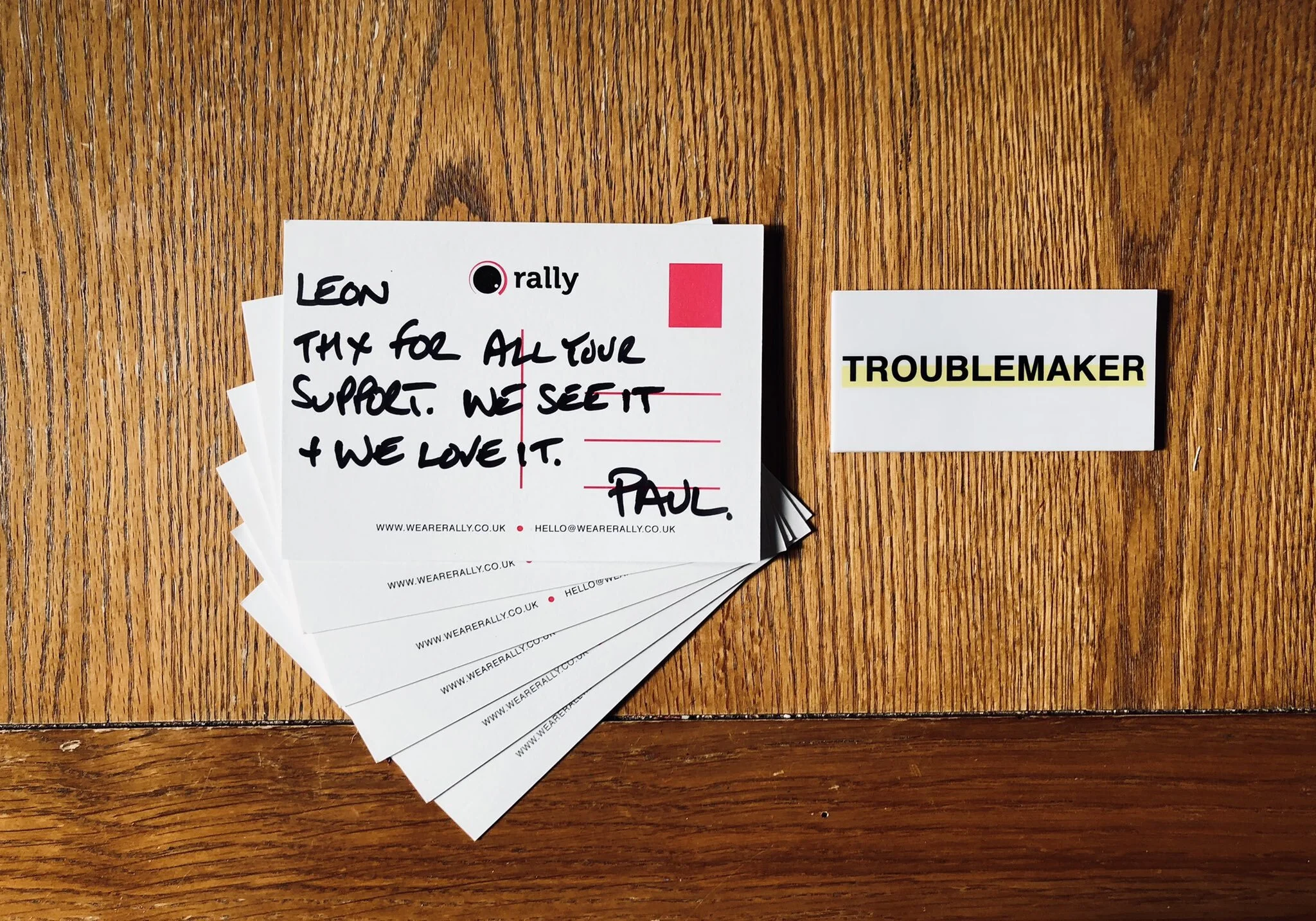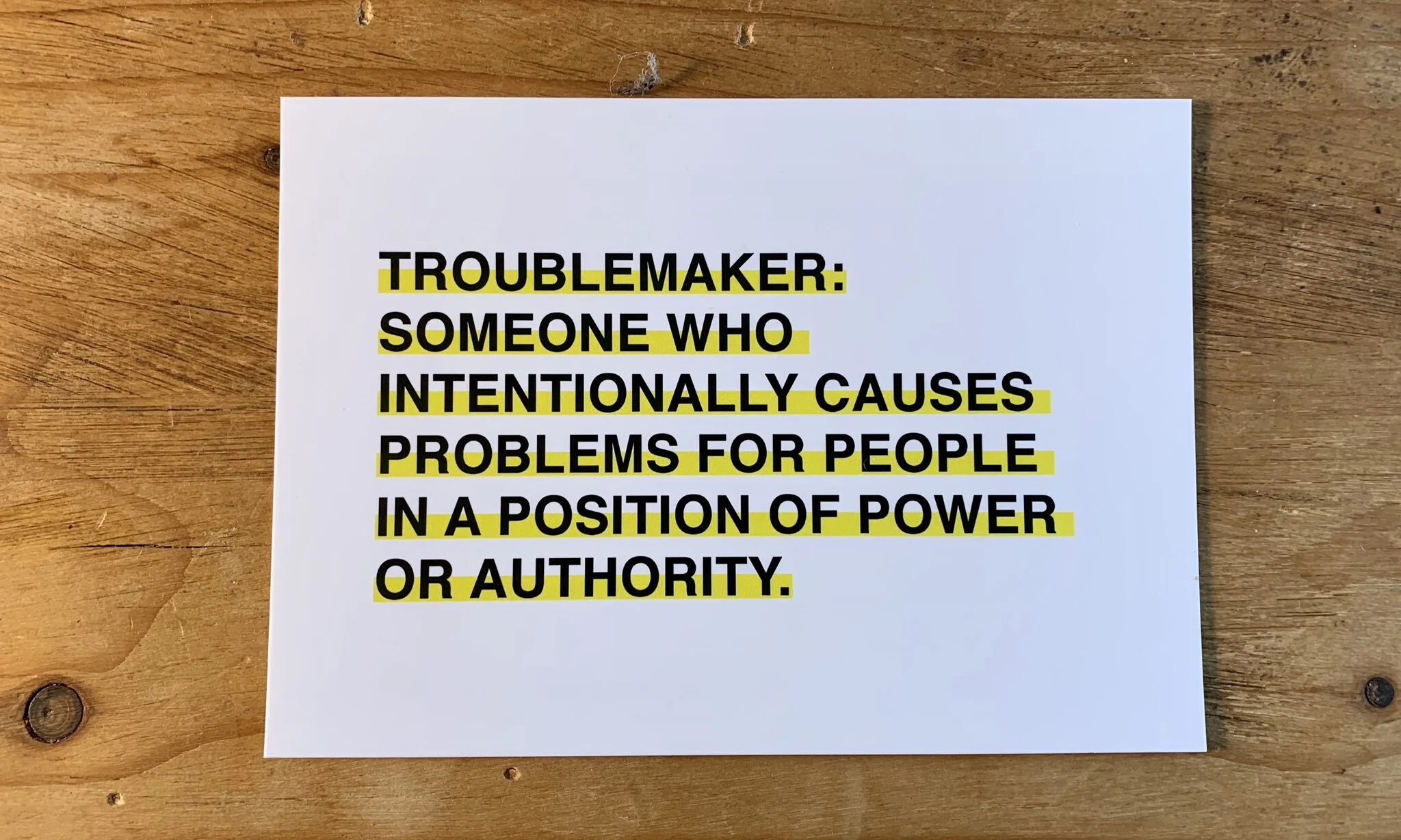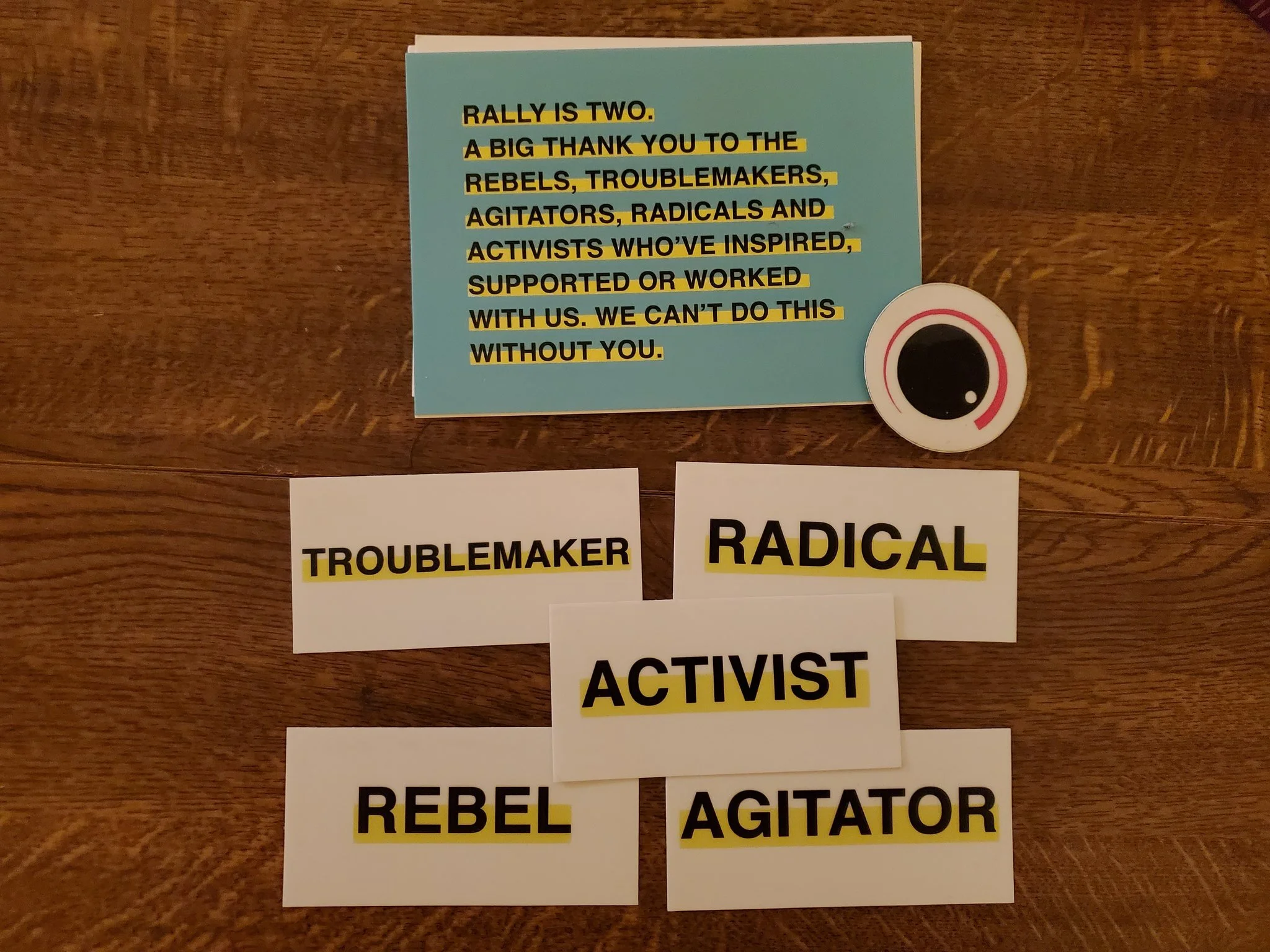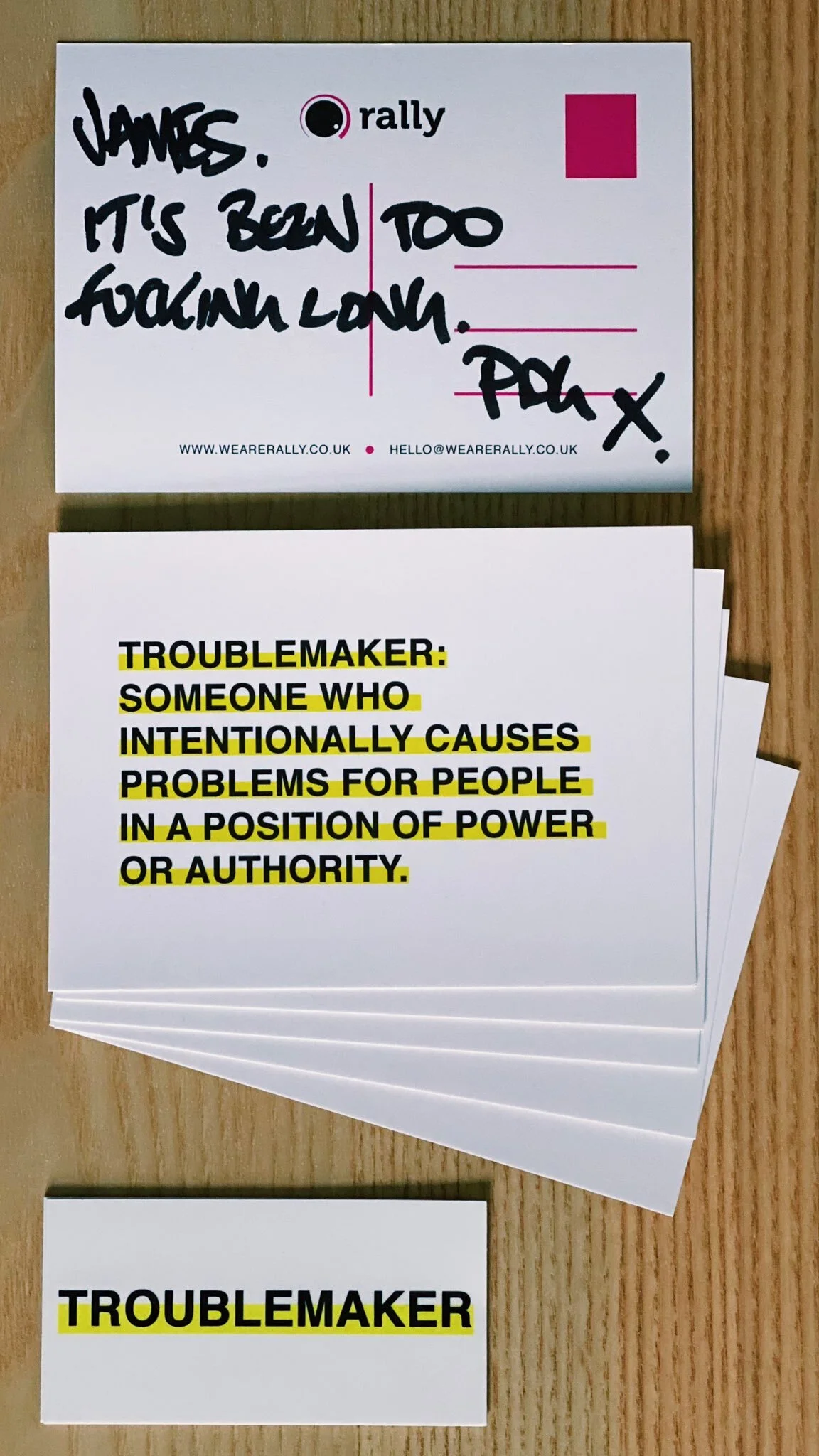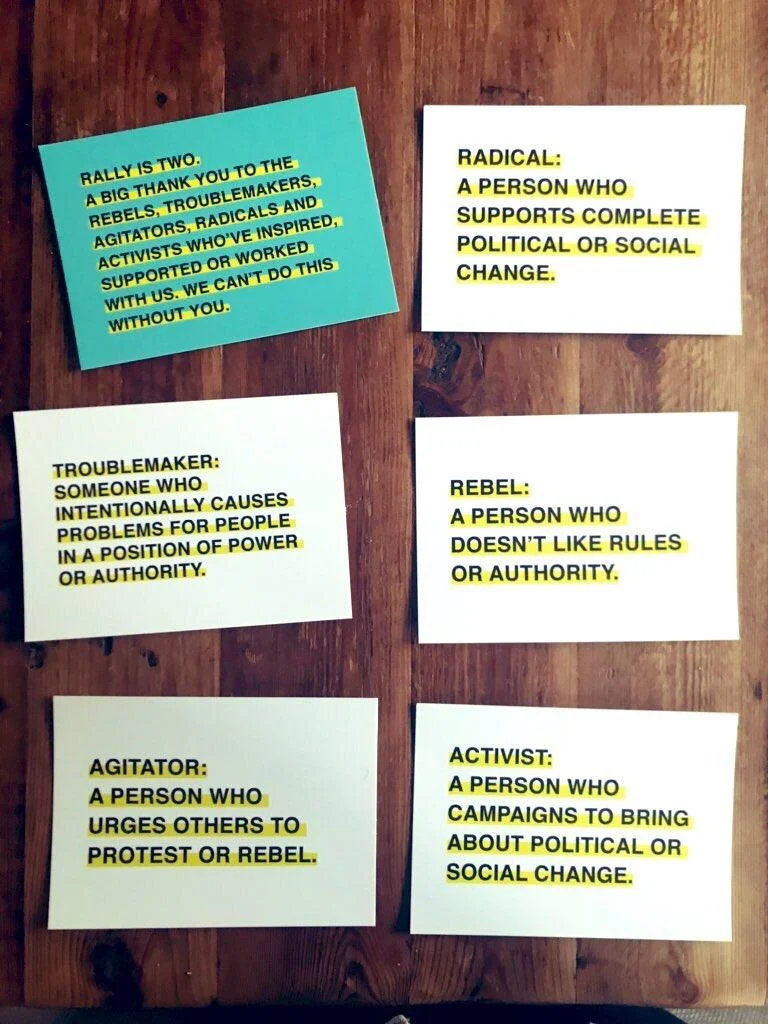Matthew is one of the few Brits to make it in the USA - we could sit for hours and listen to him tell stories from Greenpeace. Those stories are one of the reasons Rally exists: it was those stories and his commitment to fusing comms, campaigning and fundraising that formed a major inspiration for the creation of Rally.
RALLY READS: WITH GEORGIE LAMING
THANK YOU, THANK YOU, THANK YOU...
It was our second birthday recently.
To mark the passing of time we decided to send some post to all the people who inspire, support and work with us. And then this happened!
Which made us feel warm inside and very proud to be part of the community we are in.
We’ve got some stickers left if you want some.
RALLY IS TWO.
We’re now two years old.
Which means we’re on our way to becoming part of the establishment right?
Nope.
We’re just as committed today as we were two years ago to help our clients attract the public’s support at scale and convert that support into action.
We're still committed to challenging the status quo and being a positive force for change in how the sector approaches the challenges it faces.
We’re still convinced that the sector needs radical change in the way it seeks to attract the public's support in order to remain relevant. We recognise that change is unsettling and for some it’s an uncomfortable process. But it’s a necessary one. As Saul Alinksy said. ‘Change means movement. Movement means friction.’
We know we’re really lucky. We’re lucky to be a part of a brilliant community of people, clients and partner organisations who share our values and ambition.
So we want to say a HUGE thank you to our amazing clients for putting their faith in us and equal thanks to our AMAZING partners who help us make it all happen. We are immensely proud of the collaborations we’ve created and the impact that has come from them. And we’re honoured to work with such an inspiring group of radicals, rebels, agitators, activists and troublemakers.
Being part of such a badass community brings us real joy.
And before we go... Keep an eye on your letterbox. You might get a little something from us.
BLACK LIVES MATTER. RIP GEORGE FLOYD.
Recent events in the USA have enraged and numbed us. Yet another black man murdered by the police.
We found some solace in these powerful words from Killer Mike. Specifically this rallying cry…
Plot.
Plan.
Strategise.
Organise.
Mobilise.
“So, I’m duty bound to be here to simply say that it is your duty not to burn your own house down for anger with an enemy. It is your duty to fortify your own house so that you may be a house of refuge in times of organization. Now is the time to plot, plan, strategize, organize, and mobilize. It is time to beat up prosecutors you don’t like at the voting booth. It is time to hold mayoral offices accountable, chiefs and deputy chiefs.”
And this demands some of your time.
“In a racist society, it is not enough to be non-racist, we must be anti-racist”
It is clear.
White people can no longer be silent.
Take action. Do something. Speak out. Show solidarity. Anything.
Don’t make this the time you do nothing.
APPLY NEWSDESK THINKING TO GROW YOUR MOVEMENT.
Radical collaboration is important to us. And we are very lucky to operate within a fabulous community of talented people. A Barbican coffee and a catch up with the wonderful Kat Sladden of Chorus Campaigns led to us collaborating on the article below for Civil Society magazine. We’ve only just got around to posting it here. Let us know what you think…
We live in a world when a tweet from the US President sent at 2am resets the entire news agenda and when a powerful photograph can travel the world in minutes and bring more attention to a forgotten global crisis than a meeting of world leaders scheduled months in advance. As the way we consume our news has changed so has the speed people react, share opinions, spread hashtags and plan action. In this new reality, mission driven organisations that want to connect with people and make change, need to adapt to succeed. The era of the ‘five year campaign plan’ or writing emails to supporters three months in advance is over. Charities and campaigning groups need a new approach: we like to call it ‘newsdesk thinking’.
Newsdesk thinking takes lessons from how media outlets set themselves up to be flexible to react to breaking news events and adds that to smart campaign strategy, so that when the moment arises, your team can spot it quickly and has the confidence to be first out with a way supporters can channel their reaction into a constructive response.
“Organisations spend so much time and money creating contrived ‘moments’ - when there are real moments happening every single day ripe for hijacking.” Says John Coventry, who runs GoFundMe’s Europe and Australia operation and previously led Change.org’s global comms team. “There are so many News cycles happening all the time it’s hard to make sense of it all sometimes - but if your teams are set up right, empowered to execute quickly and given the space to fail well, the rewards can be huge: the perfect triangle of reputation, donations and real world impact.”
Hope Not Hate are an example of an organisation that does this brilliantly. When President Trump tweeted that the four US congress women should ‘go home’, the global outrage to this racism was instant. Hope Not Hate, who stand against racism and fascism in all its forms, decided that they needed to act, so they wrote an open letter of solidarity to the four women and asked their supporters to sign it. It gave people something to do to channel their anger in a constructive way, it showed that Hope Not Hate would act on its values even if it means taking on a President and it helped them reach out to new supporters who were mobilised in their disgust for the tweet. And this instant reaction to the news cycle resulted in close to 5,000 new people joining the Hope Not Hate email list.
Matthew McGregor, Campaigns Director at Hope Not Hate said, "This was a quick feel-good piece of campaigning. We did it because we were angry and because we thought our supporters would be too. We wanted to say something, even if it was a small thing, to send a message. And in this case we saw our list grow as a result too. It's important to have a theory of change, but our theory on this one was that sometimes it’s nice to say 'p*ss off, Mr President'.
It was this newsdesk thinking that helped grow Change.org from a small site with a few thousand signers to the world’s largest petition platform. It was a bank holiday Monday when the then Secretary of State for Work and Pensions Ian Duncan Smith said on Radio 4 that people complaining about welfare cuts were wrong and living on £50 a week was easy. The reaction on Twitter was instant. Outraged people called him out for being out of touch. Change.org’s then Director of Communications John Coventry spotted an opportunity, reaching out on Twitter to suggest that people should start a petition. Within an hour the petition to ‘get IDS to live on £50 a week’ had started and before civil servants had got back to their offices from the long weekend the petition had ten of thousands of signatures. It went on to be the first petition on the site to reach over a quarter of a million signatures and led the news agenda for over a fortnight, opening the space for people experiencing the sharp end of welfare cuts to talk about their impact.
So how can other organisations adopt newsdesk thinking, we’ve broken it down into 6 steps:
Be ready: Every media outlet has a clear editorial position. You need the same. Having a clear vision of the world you are trying to create, the issues you care about and the values you hold are the essential starting point. Newsdesk thinking isn’t about jumping in with your hot take on every Love Island breakup, it’s about knowing what you care about and being confident to act when an opportunity emerges.
Active scanning: What are people talking about today? That’s the question to keep asking. Keep an eye on leading activists on twitter, instagram and blogs. Often this is where issues rise up before they make news. It’s not about everyone in the office listening to the Today Programme, often 5 Live, Victoria Derbyshire and LBC are more helpful to get a sense of what people are talking about outside of Westminster. Consuming the news and talking about the news needs to be a part of day to day life, not just something the comms team do.
Ideas culture: Journalists are expected to turn up with new ideas for stories everyday. Building an ideas culture in your office is vital. Create a safe space for people to share without worrying if it’s a good or bad idea. It could be at daily stand ups, a ‘have you seen this?’ whatsapp group or slack channel - whatever works for your team. Not everything will lead to an action but it’s only with a culture that welcomes ideas that you’ll spot the golden opportunity quickly when it comes.
Rapid response: When a story matches your issues and values and has got people talking, speed matters. Attention spans are short and to capture the energy of the moment you need to be out with an action quickly, we’re talking hours not days. That means having a set up for rapid response campaigning - a faster sign off process, a way to queue jump to get an action email out and a nimble team that has the permission and power to move fast.
Invest in systems: Spend some time making sure that you can produce beautiful customised landing pages at speed that seamlessly integrate with your email platforms. Time after time we see organisations de-prioritise this type of work and then give the absence of these resources as a reason not to act when they should. If you build the things you need to respond quickly, you will be itching to use them and it will drive your speed of response!
Fail fast, fail forward: If you are taking more risks and testing more actions, not all of them will fly. That’s ok! After each take the time to understand what worked and what didn’t. Moving quickly means taking risks and piloting more actions, so it needs to be ok to fail and learn.
Newsdesk thinking is more than a process, it’s state of mind backed up by practical steps so when you have an idea you have the tools and processes already established to make it happen. It’s an approach that can bring real energy to how your organisation engages with the public and connect your organisation more closely to the conversations people are having everyday.
It’s fun, it’s fast and without the right attitude can deliver big results. We urge you to try it out!
Written by Kat Sladden & Paul de Gregorio: Originally posted here: Why charities should apply ‘newsdesk thinking’ to grow their movement http://bit.ly/37PcjHH
Header photo by Brad Neathery on Unsplash
THE INTERSECTION OF ART AND ACTIVISM






If you follow us on Instagram, Facebook or Twitter you will know that we obsess about the intersection between art and activism.
A constant source of inspiration is the Amplifier Foundation. Some of their amazing work is featured above.
We can’t describe them better than the way they describe themselves.
“Amplifier is a design lab that builds art to amplify the voices of grassroots movements. We work with our community of social change partners, in both the for-profit and non-profit worlds, to build symbols, language, and distribution strategies that can change the national narrative. We draw from a deep portfolio of artists to commission new art, then take the work and distribute it in unparalleled numbers through creative space hacks, reaching new audiences and driving real change.”
And this is how the illustrate their model…
In recent weeks their response to COVID-19 has been an open call for art. Looking for two specific types of work, work that conveys health and safety messages to help flatten the curve through education. And second, symbols that will help promote mental health, well-being and social change in these extremely stressful times. All the details are here.
Get involved if you feel able. And if you aren’t in the space to make art, download art from their web site and spread some positivity around your online community.
And stay safe people. We will have work to do when all this starts to ease.
Header photo by Markus Spiske on Unsplash
POSTAVME SA SPOLOČNE : LET’S STAND TOGETHER.
When we blogged about this film to mark Holocaust Memorial Day a few weeks ago we had no idea what would happen next.
You will need to view this film on YouTube.
A friend of ours from Slovakia, Zuzana Suchová, saw our post and got in touch.
Zuzana is a phenomenal human being. We met her when we spoke together at an event in Slovakia when she shared her digital fundraising story from the winning 2019 presidential campaign that saw the election of Slovakia’s first woman president.
Zuzana knew that the film would be a great way to combat the rise of a vile far right, Neo-Nazi party who were polling high in the Slovakian elections. And she asked if we could help connect her to the film’s makers, because she wanted to make a Slovakian version with Slovakian sporting celebrities. Time was of the essence because when she asked us there were only 35 days until polling day.
We decided we wanted to do everything we could to make this happen. Because, we really don’t like Nazis.
A friend of ours Juliet, connected us to Malcolm, the film director who made the original film for the Holocaust Memorial Centre here in the UK.
Malcolm is amazing. He provided all the support and guidance the team in Slovakia could ever ask for. And more.
Malcolm connected us to Marc. Marc is the Interim CEO at the Holocaust Memorial Centre. Marc was also amazing, saw exactly what we were trying to do and made it very easy for us to do it.
And then Zuzana and a group of Slovak activists, filmmakers, production professionals and sports celebrities made it happen. Lots of late nights, lots of video calls and a few wobbles later they launched this.
And they did it in less than 20 days from getting approval to launching the film.
We couldn’t be more proud of them, everyone else who collaborated to make this happen and our small role in making it happen.
And that Neo Nazi party in Slovakia? They did much worse in the elections than the polls said they would. Which is great, because we f*cking hate Nazis.
GEEK CHRISTMAS DAY
We’re not going to lie. We LOVE data. Good quality data that drives the way we think and how we identify opportunities and potential problems.
So the day that this report comes out is very special to us. And we think you will love it to.
Some highlights:
More than 4.5 billion people are using the internet at the beginning of 2020.
60% of the world’s population is online and it’s predicted that over 50% will be using social media by the end of the summer.
Global internet users will cumulatively spend over 1.25 billion years online in 2020. (Wow!).
Mobile accounts for half of all global internet use.
Social rules, with half the time we spent online spent in social.
Top four global social platforms are: 1) Facebook 2) YouTube 3) WhatsApp & 4) Facebook Messenger.
Our key takeout? You probably need a messaging strategy before a TikTok strategy.
Email us with your hot take. We’d love to hear it.
More information on the report can be found here Digital 2020: Global Digital Overview.
Main image: Photo by Calwaen Liew on Unsplash
STAND TOGETHER. DO SOMETHING.
Every now and again we see a film that knocks us off our feet and leaves us with the strong desire to take action.
This is one of those films.
As we approach Holocaust Memorial Day we urge you to watch it and to share it.
We all need to be an active participant in the fight against prejudice and hatred. We can all do something.
You can find out more about the film here.
And while you’re here, please go and take part in the Holocaust Memorial Day Trust’s #StandTogether project. All the details can be found here.
Main image: Photo by Kadir Celep on Unsplash
















